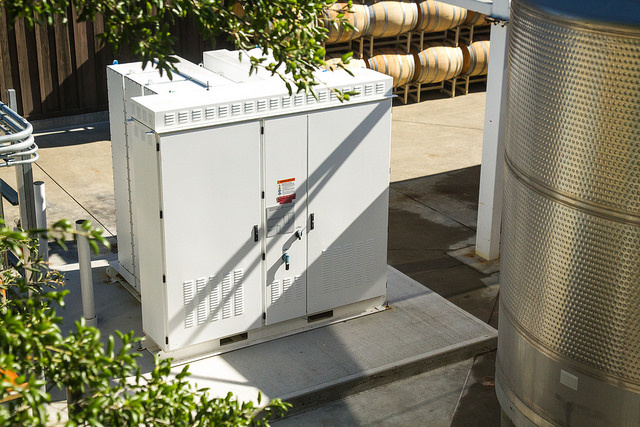Pricing energy appropriately
Flexible customer loads—such as air conditioners which can switch off their compressors for short period during periods of heavy grid use—can produce similar results.
One way utilities can create flexible consumer loads is by implementing versions of what is called demand-response pricing. With demand-response pricing, instead of paying a fixed price per unit of energy consumed, the price of electricity is variable according to the demand for it. This lets consumers choose to reduce energy usage when power is most expensive.
Currently, demand-response pricing is being refined and tested by Pratt and his researchers at PNNL, where they are working on technology to compare historical data on consumer energy use with up-to-the-minute price information on energy generation and transmission. The years-long project is the largest of its kind in the US, with participation from 11 utilities across five states. Customers in a specific area participate in a “location-specific, 5-minute double auction to return a price to the customer’s home or building energy management system, enabling an economic decision by the consumer on when to operate the appliance or load,” according to a US Department of Energy summary sheet (PDF).
This is where the smaller, consumer-facing Powerwall from Tesla could come back into play. With a demand-response model, consumers with a home battery like Tesla’s could practice power arbitrage—filling up the battery when power is cheap and using that stored energy to power the house when it’s more expensive to buy it straight from the utility.
While consumers won't see the kind of dynamic, up-to-the minute demand-response pricing that Pratt and his team are working on for years, some private companies are implementing simpler versions of demand-response pricing. When Tesla launched its line of batteries, it listed a few utilities and utility suppliers as launch partners. Among them was Southern California Edison, a subsidiary of Edison International, which is in contracts with Tesla and other battery providers to add 264 megawatts of storage to its power plants in the coming years. But the utility has already laid some groundwork for getting automated demand-response systems online. In test systems deployed at a Nordstrom department store (PDF) and at a Railex distribution center (PDF), Southern California Edison set up a system where, when the grid was at peak use, the automated system would turn off some non-essential electricity running through the companies' buildings. Doing so earned the companies incentives that reduced their electricity bills at the end of the month.
Theoretically, Southern California Edison could expand such a scheme at the household level using the integrated management software on Tesla's household Powerwall batteries. During peak load periods rather than firing up a huge additional generator or power plant, the utility could simply offer a discount to homes that can run on battery power for a few hours until the grid has a chance to recover.
Tesla, managing relationships between companies and utilities
This is already happening at Jackson Family Wines, a collection of family-owned California vineyards that currently has the largest Tesla energy installation anywhere: 21 utility-grade power packs that add up to 8.4MWh (that's 8,400kWh) of power across six Northern California wineries. Julien Gervreau, Jackson Family Wines Senior Sustainability Manager, told Ars that when Tesla approached the company, the winery had already been working with Pacific Gas & Electric (PG&E) to implement a rudimentary demand-response strategy.

Starting in 2010, PG&E began a program in which it calls up a Jackson Family Wines vineyard "30 minutes to four hours" before the power plant serving that vineyard predicts its grid will face heavy loads. The vineyard voluntarily shuts down its cooling, lighting, compressed air, and water treatment systems for two to six hours in exchange for financial incentives.
"It works pretty well for us, generally speaking, because the demand-response events are all called in by 3pm, and our workday is over by then," Gervreau said, noting that farmers work early in the morning anyway.
In 2013, Tesla approached Jackson Family Wines through the vintner's electricity management software provider, EnerNOC (also a Tesla Energy partner), and pitched the idea of battery storage. Over the following two years, Tesla performed energy load analysis at the various vineyards and created a tailored system for the company, finally delivering the 21 power pack units in January and February of this year. Currently, Jackson Family Wines uses the battery storage to perform "peak-shaving," opting to use battery-stored energy for power-intensive tasks. But Gervreau says the batteries have the software to be "smarter," and they will eventually automate the conversation that PG&E has with Jackson Family Wines on the handful of days during summer months when the power grids get overloaded.

"Tesla's really kind of managed the interrelationship," between the utility and Jackson Family Wines' new batteries, Gervreau told Ars. He noted that Tesla is even underwriting the cost of the vintner's batteries. Jackson Family Wines is splitting the amount of money it saves on its electricity bill with Tesla, which it estimates will be in the range of "hundreds of thousands of dollars annually" once all of its planned systems, plus an extensive array of solar panels, are up and running.
The final push might be the most difficult
Although micro-grids and demand-response pricing sound terrific, there is a catch. Incumbent utilities may not want to invest in more advanced schemes that make it harder for them to make money.
“That is the rub,” Pratt told Ars. “If the micro-grid is only used occasionally and only used as an emergency resource, that actually makes it easier to prevent a blackout… But if that micro-grid is operating a lot, then the grid is losing sales—significant sales.”
Similarly, as very basic demand-response systems help ease an over-burdened grid, they may be welcomed. But if demand becomes too elastic, utilities may be less willing to cooperate.
”The bottom line is regulatory restructuring of the utility business model is needed to make micro-grids not be an anathema, and some of that restructuring is underway," Pratt said. To get to a place where utilities might voluntarily choose to set up micro-grids, regulatory agencies would have to allow utilities to set higher rates during peak demand times or find some other means to entice them to build the necessary infrastructure.
At the federal level, the Supreme Court agreed last Monday to review the legality of an Obama Administration regulation which would have required utilities to pay users to reduce energy consumption during peak hours—a type of demand-response pricing. (An appellate court threw out the rule in earlier litigation.)
Some communities are already moving in the direction of micro-grids, however. “This is really important to New York" because of Superstorm Sandy, Pratt said. “There are a number of municipalities [there] that want to take the grid into their own hands.” Earlier this month, the state of New York, through its Reforming the Energy Vision (REV) initiative, gave $500,000 to utilities serving the Buffalo Niagara Medical Campus and four municipalities—Bath, Westfie, Sherburne, and the East Hampton area of Long Island—to launch feasibility studies for the construction of micro-grids.
RTI, for its part, recently launched a testbed developed in collaboration with Duke Energy, Cisco, and other companies to further its analytics software. The company "proposes re-architecting electric power grids to include a series of distributed micro-grids which will control smaller areas of demand with distributed generation and storage capacity." The test will culminate in a field deployment of smart micro-grid technology in San Antonio, Texas.
Barnett agrees that regulation has played a major role in making micro-grids the possibility that they are today. "Definitely I see [micro-grids deploying] within five years at some utilities because there’s a lot of pressure to move to adopt distributed generation," he said. "And you can only do that if you deploy micro-grids. In some places the utilities have no option but to accommodate. Typically one thinks of utilities as a slow moving industry because they’re a regulated industry. But in this case regulatory agencies are actually pushing utilities to adopt new technology much faster than they normally would."
If that prediction is right, Tesla's bet on whole-home and utility-grade batteries may prove lucrative; it'd be aided by regulatory agencies eager to move beyond the aging and vulnerable traditional power grid.
At last week's event, though, Musk made clear that his sights aren't set just on the US. "The goal is complete transformation of the entire energy infrastructure of the world,” the CEO said to fervent applause.
reader comments
144